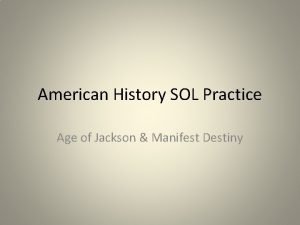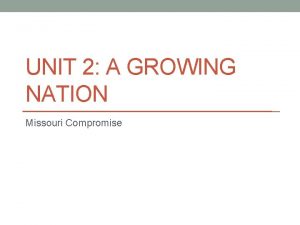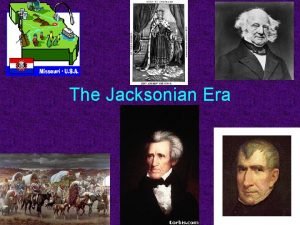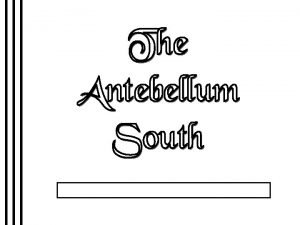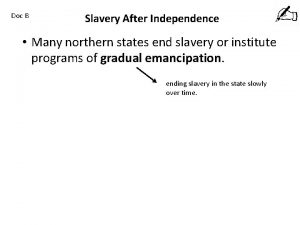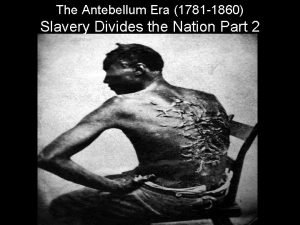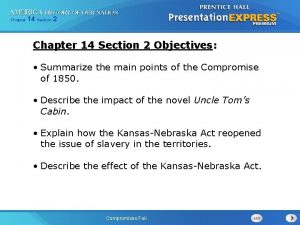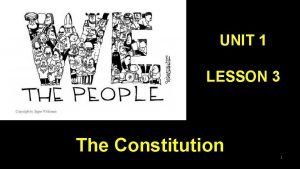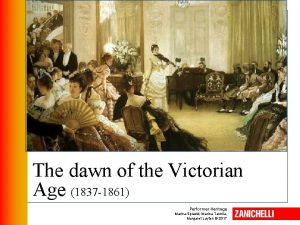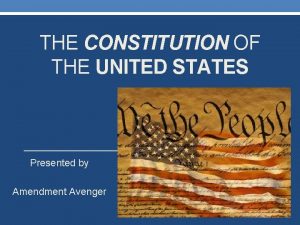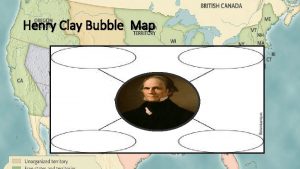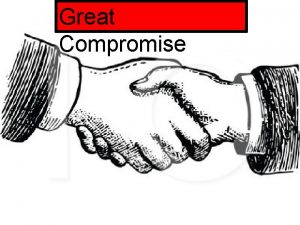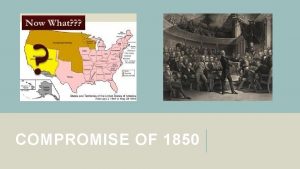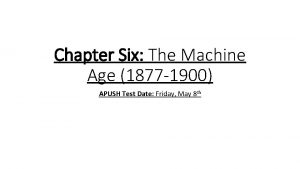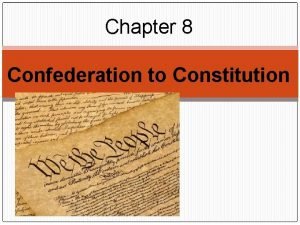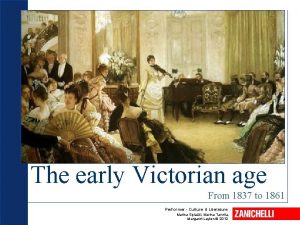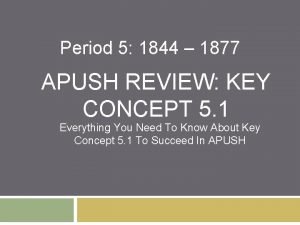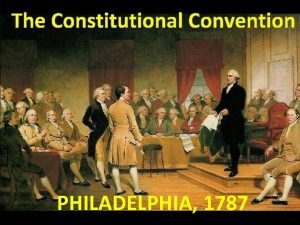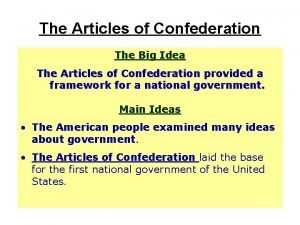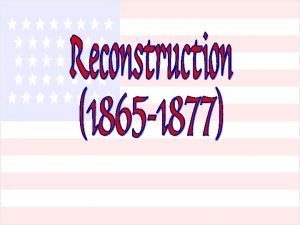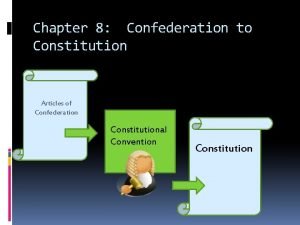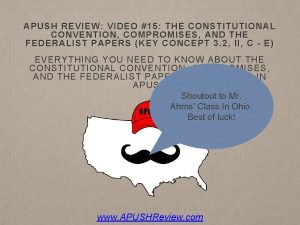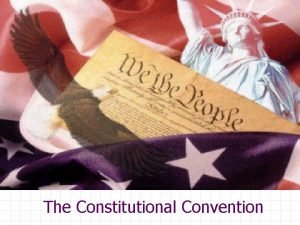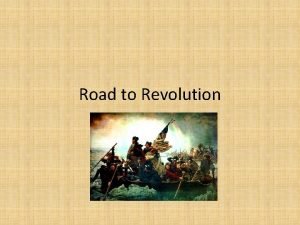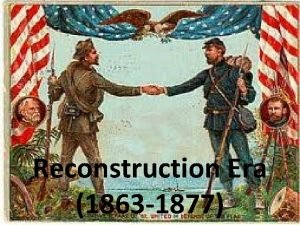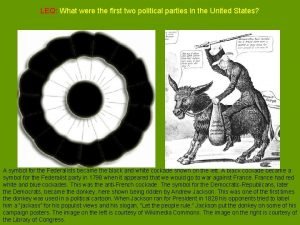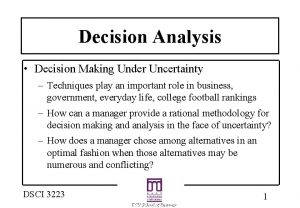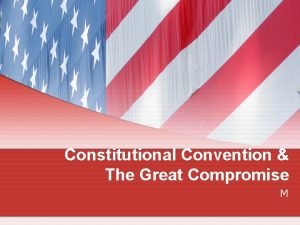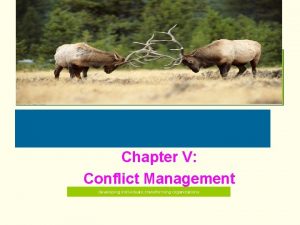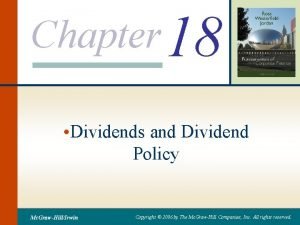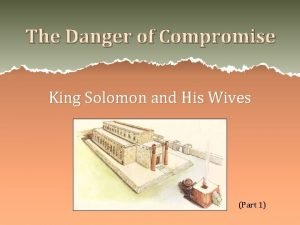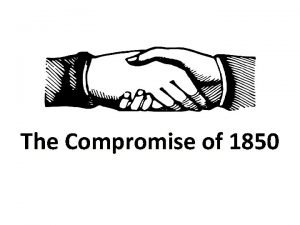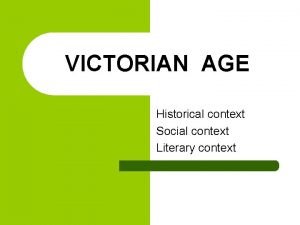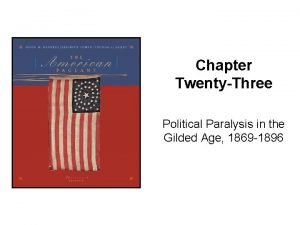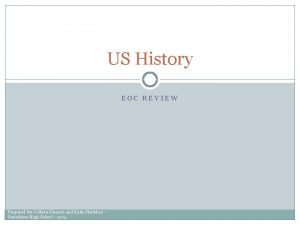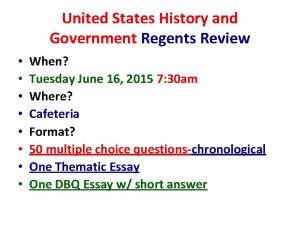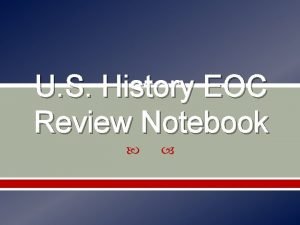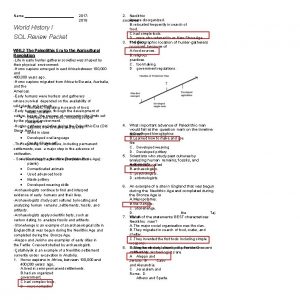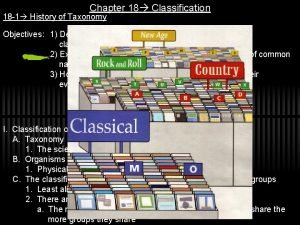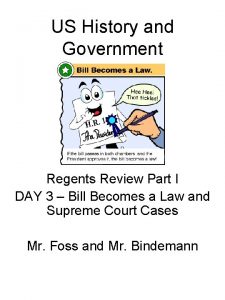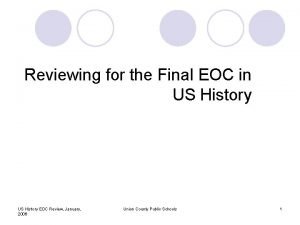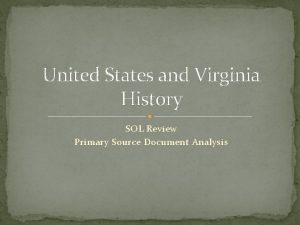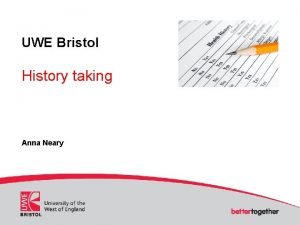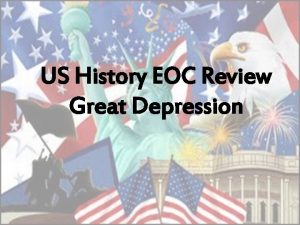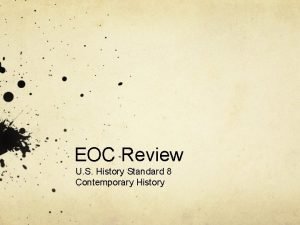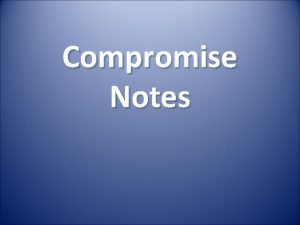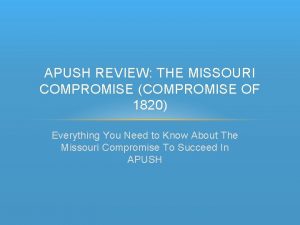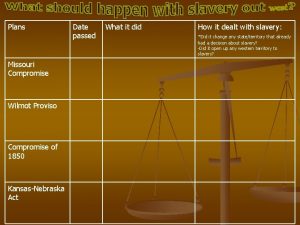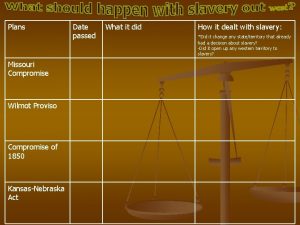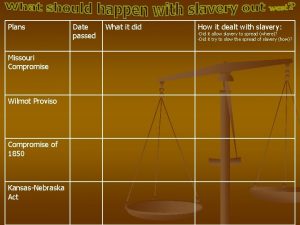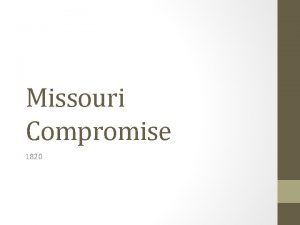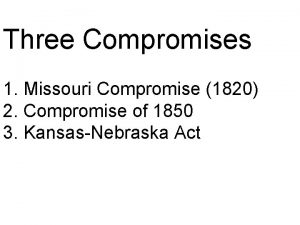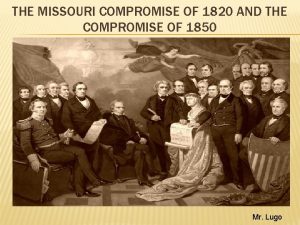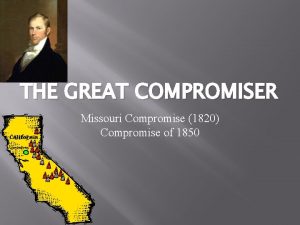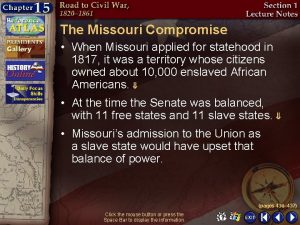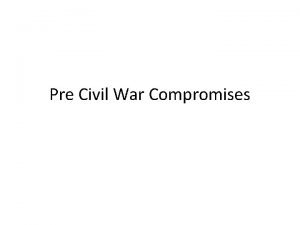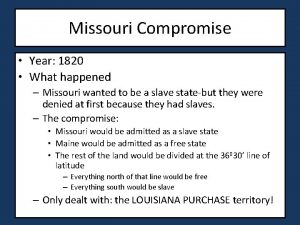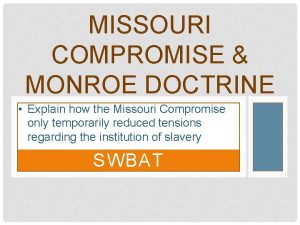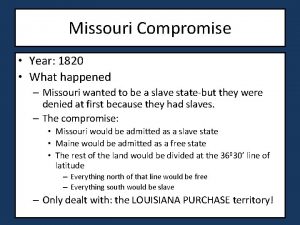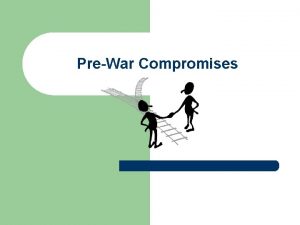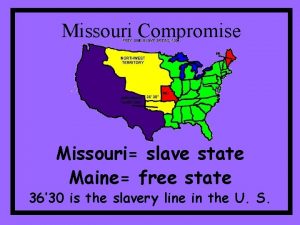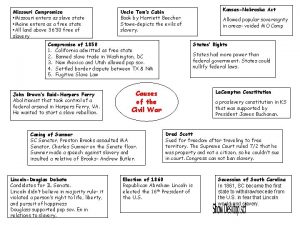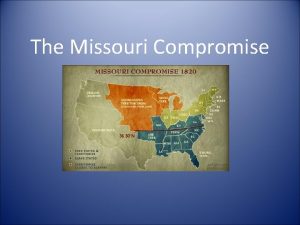US History Unit 5 Review Missouri Compromise Missouri



























































































- Slides: 91

US History Unit 5 Review

Missouri Compromise “Missouri Compromise Allows Two New States Into the Union” “Congress Agrees to Compromise of 1850” “Popular Sovereignty Adopted Under Kansas. Nebraska Act” Which issue is reflected in these headlines? (1) status of slavery in the territories and states (2) growth of agriculture on the Great Plains (3) clash of federal and state powers (4) conflicts with foreign nations over the West

Missouri Compromise The map illustrates the impact on the United States of the (1) Great Compromise (2) Missouri Compromise (3) Dred Scott decision (4) Emancipation Proclamation

Missouri Compromise Information on the map supports the conclusion that congressional leaders in 1820 and 1821 wanted to (1) maintain an equal number of free and slave states (2) ban slavery west of the Mississippi River (3) bring slavery to the Oregon Country (4) open territories in the North to slavery

Missouri Compromise Which statement about the Missouri Compromise (1820) is most accurate? (1) Slavery was banned west of the Mississippi River. (2) Unorganized territories would be governed by the United States and Great Britain. (3) The balance between free and slave states was maintained. (4) The 36° 30' line formed a new boundary between the United States and Canada.

Erie Canal The Erie Canal contributed to the development of the United States by (1) eliminating the need for railroads (2) linking the Great Lakes to the Atlantic Coast (3) becoming the major trade route to California (4) allowing southern planters to ship their cotton westward

Erie Canal How did completion of the Erie Canal in 1825 affect United States commerce? (1) New York City lost business as manufacturing centers grew in the West. (2) United States exports to European countries declined. (3) Western farmers gained better access to East Coast markets. (4) The Midwest became the center of textile production.

Erie Canal What was an immediate effect of the completion of the Erie Canal in 1825? (1) Prices increased for food products along the Atlantic Coast. (2) Farmers could more easily ship grain to eastern markets. (3) A territorial conflict began with Canada over the Great Lakes. (4) Railroads were forced to reduce their shipping rates.

Erie Canal During the 19 th century, the completion of the Erie Canal and the transcontinental railroads contributed to the industrial growth of the United States by (1) making the movement of goods easier and cheaper (2) protecting the United States from low-priced foreign imports (3) encouraging subsistence farming (4) connecting the United States to markets in Mexico and Canada

Erie Canal The completion of the Erie Canal in the early 19 th century aided the economic development of the United States by (1) supplying water for the irrigation of western farms (2) lowering the cost of shipping goods from the Midwest to the Atlantic coast (3) providing a shipping route for cotton from the South to Europe (4) supplying waterpower for running factories and mills

Erie Canal In an outline, which main topic would include the other three? (1) Erie Canal (2) 19 th-Century Internal Improvements (3) Transcontinental Railroad (4) National Road

Nullification One way in which the Kentucky and Virginia Resolutions (1798) and the South Carolina Ordinance of Nullification (1832) are similar is that each (1) claimed that individual states have the right to interpret federal laws (2) formed part of the unwritten constitution (3) supported the federal government’s power to declare war (4) provided a way for new states to enter the Union

Nullification Which heading best completes the partial outline below? (1) Foreign Policies of the United States (2) Government Policies Toward Native American Indians (3) Consequences of Manifest Destiny (4) Causes of Sectional Conflict

Nullification From 1820 to 1865, the debates over nullification, protective tariffs, and the spread of slavery into the new territories concerned the constitutional issue of the (1) balance of power between the federal and state governments (2) balance between the rights of individuals and the need to maintain order (3) protection of the rights of ethnic and racial groups (4) separation of power between the executive and legislative branches

Nullification The Articles of Confederation and theory of nullification were both attempts to (1) strengthen the national government (2) form new political parties (3) protect states’ rights (4) strengthen the presidency

Eli Whitney & The Cotton Gin This topic has only appeared in DBQ and Essay questions so far.

Spoils System President Andrew Jackson used the spoils system to (1) attack the Tariff of Abominations (2) reward supporters with United States government jobs (3) win support for construction of the Erie Canal (4) gain passage of the Indian Removal Act

Spoils System President Andrew Jackson used the spoils system to (1) veto bills he disliked (2) enforce Supreme Court decisions (3) move Native American Indians off their traditional lands (4) provide jobs to political party supporters

Spoils System During the presidency of Andrew Jackson, the spoils system resulted in (1) federal laws being nullified by the states (2) elected officials rewarding their supporters with government jobs (3) all free males being given the right to vote (4) the end of political corruption in the federal government

Indian Removal Act This term has only appeared in DBQ and Essay questions so far.

Trail of Tears Which Supreme Court decision is most closely associated with the Trail of Tears? (1) Mc. Culloch v. Maryland (1819) (2) Gibbons v. Ogden (1824) (3) Worcester v. Georgia (1832) (4) Dred Scott v. Sanford (1857)

Trail of Tears The United States government is creating memorials along the Trail of Tears because it was (1) an important road used by settlers going to the frontier (2) the location of injustices against many Native American Indians (3) the site of victories by General Andrew Jackson during the War of 1812 (4) the route followed by the first transcontinental railroad

Manifest Destiny A belief in Manifest Destiny is most closely associated with the decision to (1) create the Bank of the United States (2) suppress the Whiskey Rebellion (3) declare war on Mexico (4) build the Panama Canal

Manifest Destiny Which action is most closely associated with the term Manifest Destiny? (1) declaring independence from Great Britain (2) deciding to end the War of 1812 (3) acquiring territory from Mexico in 1848 (4) annexing Hawaii and the Philippines

Manifest Destiny was used to justify an American desire to (1) limit the number of immigrants entering the country (2) control the area located east of the Appalachian Mountains (3) expand the United States to the Pacific Ocean (4) warn European countries against colonizing Latin America

Manifest Destiny The principal goal of the supporters of Manifest Destiny in the 1840 s was to (1) convince Canada to become part of the United States (2) expand United States territory to the Pacific Ocean (3) build a canal across Central America (4) acquire naval bases in the Caribbean

Manifest Destiny In the 1840 s, the term Manifest Destiny was used by many Americans to justify (1) the extension of slavery into the territories (2) war with Russia over the Oregon territory (3) the acquisition of colonies in Latin America (4) westward expansion into lands claimed by other nations

Manifest Destiny The foreign policies of President James Polk involving Texas, California, and the Oregon Territory were all efforts to (1) remain neutral toward western territories (2) continue traditional American isolationism (3) weaken the Monroe Doctrine (4) fulfill the goal of Manifest Destiny

Manifest Destiny The slogan “Fifty-four forty or fight!, ” the annexation of Texas, and the Mexican War all relate to the (1) theory of nullification (2) practice of secession (3) belief in Manifest Destiny (4) idea of due process

Manifest Destiny The annexation of Texas and the Mexican Cession are best described as efforts by the United States to (1) remove European threats (2) limit the spread of slavery (3) end wars of aggression (4) fulfill Manifest Destiny

Manifest Destiny Which term did Americans use in the 1840 s to describe the idea that the United States should possess the entire continent? (1) containment (2) globalization (3) Manifest Destiny (4) popular sovereignty

Manifest Destiny The term Manifest Destiny was first used to support (1) independence from Great Britain (2) westward expansion to the Pacific Ocean (3) efforts to stop secession of Southern states (4) laws restricting labor union activity

Manifest Destiny In which war was Manifest Destiny used to justify United States government actions? (1) Revolutionary War (2) Mexican War (3) Civil War (4) Vietnam War

Manifest Destiny In the 1840 s, President James K. Polk’s belief in Manifest Destiny led to (1) a war with Mexico (2) an alliance with several South American nations (3) the establishment of new colonies in the Caribbean (4) a ban on the activities of northern abolitionists

Mexican War The slogan “Fifty-four forty or fight!, ” the annexation of Texas, and the Mexican War all relate to the (1) theory of nullification (2) practice of secession (3) belief in Manifest Destiny (4) idea of due process

Mexican War In which war was Manifest Destiny used to justify United States government actions? (1) Revolutionary War (2) Mexican War (3) Civil War (4) Vietnam War

Mexican War In the 1840 s, President James K. Polk’s belief in Manifest Destiny led to (1) a war with Mexico (2) an alliance with several South American nations (3) the establishment of new colonies in the Caribbean (4) a ban on the activities of northern abolitionists

Seneca Falls (1848) A goal that was established at the Seneca Falls Convention of 1848 was achieved in 1920 by the (1) creation of a free public education system (2) passage of legislation to end child labor (3) adoption of national woman’s suffrage (4) ratification of an amendment requiring national Prohibition

Seneca Falls (1848) Which 19 th-century event supported the movement for women’s rights? (1) Seneca Falls Convention (2) Dred Scott decision (3) formation of the Republican Party (4) Lincoln-Douglas debates

Seneca Falls (1848) The Declaration of Sentiments, adopted at the Seneca Falls Convention in 1848, was significant because it (1) promoted the idea of equal rights for women (2) demanded the immediate abolition of slavery (3) called for the prohibition of alcoholic beverages (4) asked government to restrict harmful business practices

Seneca Falls (1848) The Declaration of Sentiments, adopted during the Seneca Falls Convention in 1848, is most closely associated with the rights of (1) immigrants (2) enslaved persons (3) Native American Indians (4) women

Seneca Falls (1848) The Seneca Falls Convention of 1848 was mainly concerned with (1) ending slavery in all the states (2) reducing consumption of alcoholic beverages (3) improving treatment of the mentally ill (4) expanding women’s rights

Seneca Falls (1848) The Seneca Falls Convention of 1848 is often viewed as the beginning of the (1) temperance movement (2) women’s rights movement (3) antislavery movement (4) Native American Indian movement

Seneca Falls (1848) A goal set at the Seneca Falls Convention (1848) was achieved during the Progressive Era by the (1) formation of the federal Food and Drug Administration (2) creation of the League of Nations (3) adoption of a national income tax (4) ratification of the woman’s suffrage amendment

Declaration of Sentiments The Declaration of Sentiments, adopted at the Seneca Falls Convention in 1848, was significant because it (1) promoted the idea of equal rights for women (2) demanded the immediate abolition of slavery (3) called for the prohibition of alcoholic beverages (4) asked government to restrict harmful business practices

Declaration of Sentiments The Declaration of Sentiments, adopted during the Seneca Falls Convention in 1848, is most closely associated with the rights of (1) immigrants (2) enslaved persons (3) Native American Indians (4) women

Declaration of Sentiments The Declaration of Sentiments from the Seneca Falls Convention of 1848 proclaimed that (1) the abolition of slavery was necessary (2) all men and women are created equal (3) California should be admitted as a free state (4) the sale of alcoholic beverages should be illegal

Women’s Rights (Suffrage) What does the map show about woman’s suffrage legislation before ratification of the federal woman’s suffrage amendment in 1920? (1) Opposition to woman’s suffrage was strongest in the New England states. (2) New York was the first state to grant women the right to vote in state elections. (3) State legislatures never gave women the right to vote. (4) Many western states granted women suffrage before passage of the 19 th amendment.

Women’s Rights (Suffrage) According to the map, in which region of the United States did women receive the most support for equal suffrage before passage of the 19 th amendment? (1) East (2) North (3) South (4) West

Women’s Rights (Suffrage) During World War I, many American women helped gain support for the suffrage movement by (1) protesting against the war (2) joining the military service (3) lobbying for child-care facilities (4) working in wartime industries

Women’s Rights (Suffrage) Information in the cartoon most clearly supports the conclusion that by 1914 (1) states along the East Coast had granted full voting rights to women (2) women could vote only in state elections (3) most states had approved at least some voting rights for women (4) complete national suffrage for women had been achieved

Women’s Rights (Suffrage) A goal set at the Seneca Falls Convention (1848) was achieved during the Progressive Era by the (1) formation of the federal Food and Drug Administration (2) creation of the League of Nations (3) adoption of a national income tax (4) ratification of the woman’s suffrage amendment

Women’s Rights (Suffrage) A goal that was established at the Seneca Falls Convention of 1848 was achieved in 1920 by the (1) creation of a free public education system (2) passage of legislation to end child labor (3) adoption of national woman’s suffrage (4) ratification of an amendment requiring national Prohibition

Women’s Rights (Suffrage) Which conclusion about woman’s suffrage is best supported by the information in the chart? (1) Congress did not allow women to vote in the territories. (2) Before 1917, many of the western states had granted women the right to vote. (3) The United States Supreme Court had to approve a woman’s right to vote in each state. (4) Women were permitted to vote only in state elections.

Women’s Rights (Suffrage) What was a major reason most western states granted women suffrage prior to the adoption of the 19 th amendment? (1) Western states had more college-educated women than the eastern states. (2) Women outnumbered men in states west of the Mississippi River. (3) A majority of western states had legislatures controlled by women. (4) The important roles played by frontier women promoted equality.

Sectionalism The Supreme Court ruling in Dred Scott v. Sanford (1857) helped to increase sectional conflict because the decision (1) denied Congress the power to regulate slavery in the territories (2) allowed for the importation of enslaved persons for ten years (3) prohibited slavery in lands west of the Mississippi River (4) gave full citizenship to all enslaved persons

Sectionalism One way that “Bleeding Kansas, ” the Dred Scott decision, and John Brown’s raid on Harper’s Ferry had a similar effect on the United States was that these events (1) ended conflict over slavery in the territories (2) eased tensions between the North and the South (3) contributed to the formation of the Whig Party (4) made sectional compromise more difficult

Sectionalism Which heading best completes the partial outline below? (1) Foreign Policies of the United States (2) Government Policies Toward Native American Indians (3) Consequences of Manifest Destiny (4) Causes of Sectional Conflict

Abolitionism “Uncle Tom’s Cabin Stirs Controversy” “Kansas Rocked by Bloody Conflict” “John Brown’s Raid Angers South” Which statement about the United States in the 1850 s is best supported by these headlines? (1) The nation had grown increasingly divided over the future of slavery. (2) Americans had lost confidence in the plan for Reconstruction. (3) Northern and Southern voters were united in support of popular sovereignty. (4) Support for the abolitionist movement decreased during this period.

Abolitionism Which person’s action was most closely associated with the abolitionist movement? (1) William Lloyd Garrison’s publication of The Liberator (2) Booker T. Washington’s commitment to African American education (3) Thurgood Marshall’s legal argument in Brown v. Board of Education of Topeka (4) Martin Luther King, Jr. ’s leadership of the Birmingham march

Abolitionism Prior to the Civil War, abolitionists reacted to the situation described in the poster by (1) supporting the Underground Railroad (2) opposing the Emancipation Proclamation (3) banning freed slaves from Northern states (4) proposing a stricter fugitive slave law

Abolitionism Abolitionists in the pre–Civil War period were most likely to support the (1) removal of the Cherokee Indians from Georgia (2) passage of the Fugitive Slave Act (3) activities of the Underground Railroad (4) use of popular sovereignty in the territories

Fugitive Slave Act This poster from the 1850 s appeared in response to the (1) passage of the fugitive slave law (2) start of the Civil War (3) issuance of the Emancipation Proclamation (4) enactment of the 13 th Amendment

Fugitive Slave Act Prior to the Civil War, abolitionists reacted to the situation described in the poster by (1) supporting the Underground Railroad (2) opposing the Emancipation Proclamation (3) banning freed slaves from Northern states (4) proposing a stricter fugitive slave law

Fugitive Slave Act In the 1850 s, why did many runaway slaves go to Canada? (1) They feared being drafted into the Northern army. (2) The Fugitive Slave Act kept them at risk in the United States. (3) More factory jobs were available in Canada. (4) Northern abolitionists refused to help fugitive slaves.

Compromise of 1850 The Missouri Compromise (1820), the Compromise of 1850, and the Kansas-Nebraska Act (1854) were all efforts to (1) end fighting between mid-western farmers and Native American Indians (2) encourage manufacturing in the West (3) increase the number of people who voted in presidential elections (4) settle disputes over the spread of slavery to the western territories

Compromise of 1850 “Missouri Compromise Allows Two New States Into the Union” “Congress Agrees to Compromise of 1850” “Popular Sovereignty Adopted Under Kansas. Nebraska Act” Which issue is reflected in these headlines? (1) status of slavery in the territories and states (2) growth of agriculture on the Great Plains (3) clash of federal and state powers (4) conflicts with foreign nations over the West

Compromise of 1850 “Compromise Enables Maine and Missouri to Enter the Union” “California Joins the Union As Part of Compromise of 1850” “Kansas-Nebraska Act Establishes Popular Sovereignty in the Territories” Which issue is most closely associated with these headlines? (1) status of slavery in new states (2) negotiation of the Oregon Treaty (3) expansion of land for reservations (4) influence of political parties on economic development

Compromise of 1850 The rapid westward migration caused by the discovery of gold in California led directly to (1) the start of the Civil War (2) the adoption of the Compromise of 1850 (3) increased trade through the Panama Canal (4) control of the United States Senate by the slave states

Compromise of 1850 In the Compromise of 1850 and the Kansas. Nebraska Act of 1854, popular sovereignty was proposed as a way to (1) allow northern states the power to ban slavery (2) deny southern states the legal right to own slaves (3) allow settlers in new territories to vote on the issue of slavery (4) overturn previous Supreme Court decisions on slavery

Kansas-Nebraska Act & Popular Sovereignty The Missouri Compromise (1820), the Compromise of 1850, and the Kansas-Nebraska Act (1854) were all efforts to (1) end fighting between Midwestern farmers and Native American Indians (2) encourage manufacturing in the West (3) increase the number of people who voted in presidential elections (4) settle disputes over the spread of slavery to the western territories

Kansas-Nebraska Act & Popular Sovereignty The principle of popular sovereignty was an important part of the (1) Indian Removal Act (2) Kansas-Nebraska Act (3) Homestead Act (4) Dawes Act

Kansas-Nebraska Act & Popular Sovereignty “Missouri Compromise Allows Two New States Into the Union” “Congress Agrees to Compromise of 1850” “Popular Sovereignty Adopted Under Kansas. Nebraska Act” Which issue is reflected in these headlines? (1) status of slavery in the territories and states (2) growth of agriculture on the Great Plains (3) clash of federal and state powers (4) conflicts with foreign nations over the West

Kansas-Nebraska Act & Popular Sovereignty “Compromise Enables Maine and Missouri to Enter the Union” “California Joins the Union As Part of Compromise of 1850” “Kansas-Nebraska Act Establishes Popular Sovereignty in the Territories” Which issue is most closely associated with these headlines? (1) status of slavery in new states (2) negotiation of the Oregon Treaty (3) expansion of land for reservations (4) influence of political parties on economic development

Kansas-Nebraska Act & Popular Sovereignty In the Compromise of 1850 and the Kansas. Nebraska Act of 1854, popular sovereignty was proposed as a way to (1) allow northern states the power to ban slavery (2) deny southern states the legal right to own slaves (3) allow settlers in new territories to vote on the issue of slavery (4) overturn previous Supreme Court decisions on slavery

Kansas-Nebraska Act & Popular Sovereignty Which heading best completes the partial outline below? (1) Foreign Policies of the United States (2) Government Policies Toward Native American Indians (3) Consequences of Manifest Destiny (4) Causes of Sectional Conflict

Kansas-Nebraska Act & Popular Sovereignty Which term refers to the idea that settlers had the right to decide whether slavery would be legal in their territory? (1) nullification (2) sectionalism (3) popular sovereignty (4) southern secession

Harriet Beecher Stowe’s Uncle Tom’s Cabin William Lloyd Garrison, Harriet Tubman, and Harriet Beecher Stowe are best known for their efforts to (1) create free public schools (2) begin the temperance movement (3) expand the rights of women (4) oppose the practice of slavery

Harriet Beecher Stowe’s Uncle Tom’s Cabin The publication of Uncle Tom’s Cabin, written by Harriet Beecher Stowe, contributed to the start of the Civil War by (1) exposing the dangers of cotton manufacturing (2) intensifying Northern dislike of slavery (3) pressuring the president to support emancipation (4) convincing Congress to ban the importation of slaves

Harriet Beecher Stowe’s Uncle Tom’s Cabin “Uncle Tom’s Cabin Stirs Controversy” “Kansas Rocked by Bloody Conflict” “John Brown’s Raid Angers South” Which statement about the United States in the 1850 s is best supported by these headlines? (1) The nation had grown increasingly divided over the future of slavery. (2) Americans had lost confidence in the plan for Reconstruction. (3) Northern and Southern voters were united in support of popular sovereignty. (4) Support for the abolitionist movement decreased during this period.

Harriet Beecher Stowe’s Uncle Tom’s Cabin Books such as Uncle Tom’s Cabin, How the Other Half Lives, and The Feminine Mystique all show that literature can sometimes (1) expose government corruption (2) cause violent revolution (3) begin military conflict (4) encourage social reform

Underground Railroad & Harriet Tubman Prior to the Civil War, abolitionists reacted to the situation described in the poster by (1) supporting the Underground Railroad (2) opposing the Emancipation Proclamation (3) banning freed slaves from Northern states (4) proposing a stricter fugitive slave law

Underground Railroad & Harriet Tubman Abolitionists in the pre–Civil War period were most likely to support the (1) removal of the Cherokee Indians from Georgia (2) passage of the Fugitive Slave Act (3) activities of the Underground Railroad (4) use of popular sovereignty in the territories

Underground Railroad & Harriet Tubman William Lloyd Garrison, Harriet Tubman, and Harriet Beecher Stowe are best known for their efforts to (1) create free public schools (2) begin the temperance movement (3) expand the rights of women (4) oppose the practice of slavery

Dred Scott vs Sanford (1857) One way that “Bleeding Kansas, ” the Dred Scott decision, and John Brown’s raid on Harper’s Ferry had a similar effect on the United States was that these events (1) ended conflict over slavery in the territories (2) eased tensions between the North and the South (3) contributed to the formation of the Whig Party (4) made sectional compromise more difficult

Dred Scott vs Sanford (1857) Most Southern political leaders praised the Supreme Court decision in Dred Scott v. Sanford (1857) because it (1) granted citizenship to all enslaved persons (2) upheld the principle of popular sovereignty (3) supported the right of a state to secede from the Union (4) protected the property rights of slave owners in the territories

Dred Scott vs Sanford (1857) The Supreme Court ruling in Dred Scott v. Sanford (1857) helped to increase sectional conflict because the decision (1) denied Congress the power to regulate slavery in the territories (2) allowed for the importation of enslaved persons for ten years (3) prohibited slavery in lands west of the Mississippi River (4) gave full citizenship to all enslaved persons

Dred Scott vs Sanford (1857) Which Supreme Court decision created the need for a constitutional amendment that would grant citizenship to formerly enslaved persons? (1) Marbury v. Madison (2) Mc. Culloch v. Maryland (3) Worcester v. Georgia (4) Dred Scott v. Sanford

Dred Scott vs Sanford (1857) The Supreme Court decision in Dred Scott v. Sanford (1857) was significant because it (1) allowed slavery in California (2) outlawed slavery in the Southern States (3) upheld the actions of the Underground Railroad (4) ruled that Congress could not ban slavery in the territories

Dred Scott vs Sanford (1857) Which heading best completes the partial outline below? (1) Foreign Policies of the United States (2) Government Policies Toward Native American Indians (3) Consequences of Manifest Destiny (4) Causes of Sectional Conflict

Election of 1860 • This topic Appeared only one time in a DBQ question. • Significance • Southerners believed Lincoln would attempt so abolish slavery if elected. • When he won the election Southern states (beginning with South Carolina) began to secede (or separate) from the Union.
 What ideas did the measure contain the missouri compromise
What ideas did the measure contain the missouri compromise Manifest destiny was used to justify an american desire to
Manifest destiny was used to justify an american desire to Where did the missouri compromise imaginary line run
Where did the missouri compromise imaginary line run Missouri compromise
Missouri compromise Missouri compromise
Missouri compromise Missouri compromise
Missouri compromise What states had slavery
What states had slavery Missouri compromise
Missouri compromise What undid the missouri compromise
What undid the missouri compromise Unit 10, unit 10 review tests, unit 10 general test
Unit 10, unit 10 review tests, unit 10 general test Unit 1 test review us history
Unit 1 test review us history Unit test algebra 2
Unit test algebra 2 What was the goal of reconstruction
What was the goal of reconstruction 3/5 compromise
3/5 compromise The dawn of the victorian age powerpoint
The dawn of the victorian age powerpoint Connecticut compromise
Connecticut compromise What is respiratory compromise
What is respiratory compromise Explain the compromise of 1850
Explain the compromise of 1850 Which statement about the great compromise is accurate?
Which statement about the great compromise is accurate? 3/5 compromise cartoon
3/5 compromise cartoon Who created the compromise of 1850? *
Who created the compromise of 1850? * Haymarket square riot apush
Haymarket square riot apush Three fifths compromise example
Three fifths compromise example The victorian compromise
The victorian compromise Electoral college compromise 1787
Electoral college compromise 1787 Anthony comstock apush
Anthony comstock apush Compromise of 1877
Compromise of 1877 Indication of transfusion
Indication of transfusion Access matrix in os
Access matrix in os Constitutional convention compromise
Constitutional convention compromise Articles of confederation big ideas
Articles of confederation big ideas Whats the compromise of 1877
Whats the compromise of 1877 Va plan nj plan great compromise
Va plan nj plan great compromise Whats the compromise of 1877
Whats the compromise of 1877 The great compromise simplified
The great compromise simplified Great compromise apush
Great compromise apush Weaknesses of articles of confederation
Weaknesses of articles of confederation When was the great compromise
When was the great compromise Define reconstruction era
Define reconstruction era Great compromise
Great compromise Compromise space
Compromise space Compromise dividend policy
Compromise dividend policy Hurwicz approach is a compromise between
Hurwicz approach is a compromise between Great compromise definition
Great compromise definition Great compromise definition
Great compromise definition Incompatible goals
Incompatible goals Mc stock dividend
Mc stock dividend Compromise dividend policy
Compromise dividend policy 1 kings 7
1 kings 7 Compromise of 1850
Compromise of 1850 Money ideology compromise ego
Money ideology compromise ego Compromise of 1850
Compromise of 1850 Safety no compromise
Safety no compromise Compromise of 1850
Compromise of 1850 What is sociocultural context in literature
What is sociocultural context in literature Orderly visual search pattern
Orderly visual search pattern Photosynthesis transpiration compromise
Photosynthesis transpiration compromise Compromise adjective
Compromise adjective The key tradeoff featured in the compromise of 1877
The key tradeoff featured in the compromise of 1877 Chapter review motion part a vocabulary review answer key
Chapter review motion part a vocabulary review answer key Ap gov review final exam review
Ap gov review final exam review Narrative review vs systematic review
Narrative review vs systematic review What is inclusion and exclusion
What is inclusion and exclusion Narrative review vs systematic review
Narrative review vs systematic review World history spring final exam review answers
World history spring final exam review answers Florida us history eoc review
Florida us history eoc review Us history regents review
Us history regents review Us history eoc review notebook
Us history eoc review notebook 11th grade us history staar review games
11th grade us history staar review games Kahoot staar review
Kahoot staar review World history ii sol review packet
World history ii sol review packet World history semester 2 final review packet
World history semester 2 final review packet World history fall semester exam review
World history fall semester exam review Section 18-1 review history of taxonomy
Section 18-1 review history of taxonomy 1450*3
1450*3 American history semester 2 final exam
American history semester 2 final exam Us history regents practice
Us history regents practice Epicurus taught that pleasure ________.
Epicurus taught that pleasure ________. Semester 1 final exam study guide us history
Semester 1 final exam study guide us history Us history
Us history Day 1 us history eoc review
Day 1 us history eoc review World history semester 1 final exam study guide answers
World history semester 1 final exam study guide answers World history 1st semester final review answers
World history 1st semester final review answers History sol review
History sol review Ap world history jeopardy review game
Ap world history jeopardy review game World history final exam study guide
World history final exam study guide Pain history taking
Pain history taking Us history eoc review the great depression and the new deal
Us history eoc review the great depression and the new deal Day 8 us history eoc review
Day 8 us history eoc review Systematic review in history taking
Systematic review in history taking Also history physical
Also history physical Unit 9 human body systems review
Unit 9 human body systems review

